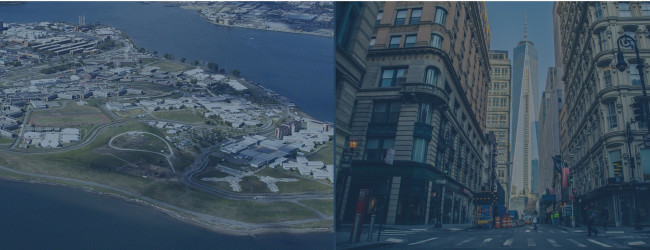on May 31, 2017
A New Life for Rikers Island
By: Bret Collazzi

HR&A is proud to have contributed to the Independent Commission on New York City Criminal Justice and Incarceration Reform, which released a report this Spring that advocated for justice reform, the closure of Rikers Island, and new uses for the 400+ acre site would enable the island to go from a place of injustice to a place of great public benefit. The vision we helped create for a reimagined island includes critical next-generation infrastructure such as: expanded airport runway capacity; modern wastewater treatment and waste management facilities; and renewable energy production and storage. Recommended uses would create over 50,000 jobs, produce enough renewable energy to power up to 30,000 homes, and reduce the amount of waste sent to landfills by 40%, positively contributing to the city’s economic growth and environmental quality. Coinciding with the release of the report, Mayor Bill de Blasio’s committed to close Rikers Island within the next decade. Innovative thinking and interdisciplinary design will be key to enabling important social reforms as we look toward the decades ahead.
Rikers Island is a roughly 400-acre, largely manmade island only 5 miles from Midtown Manhattan. It has been used almost exclusively to imprison New Yorkers – as many as 20,000 at the height of the drug epidemic and approximately 7,500 today – for the past 100 years. In March 2016, prompted by reports of endemic abuse on the island, New York City Council Speaker Melissa Mark-Viverito convened an independent commission to study the city’s criminal justice system. As discussions of closing the jail began in earnest, an important question emerged: if Rikers Island were not a jail, what could it be?
The sudden availability of 400 developable acres in a global real estate capital conjured images of high-rise housing and exclusive destinations to some. But the island faces serious physical limitations that limit its value: isolation from transit, poor soil conditions, an FAA-imposed 15-story height limit, and the buzz of planes departing LaGuardia Airport, whose runway sits only a few hundred feet away. More essentially, the Commission was clear that any uses proposed for the island should help address the damage that the city’s incarceration system has exacted on families and communities, particularly low-income and minority communities.
Uses that would directly benefit impacted communities, such as affordable housing, public open space, or employment hubs, would be costlier to build on Rikers than elsewhere and would be isolated from the city. Our team sought to creatively convert these challenges into advantages and to simultaneously address larger challenges facing the region. The resulting vision is an island transformed: from the vestige of a shameful past to a vital and unprecedented collection of sustainable city infrastructure that can address climate change, improve the environment, and position New York to compete as a 21st-century global city.
Published in April 2017, the Rikers redevelopment concept plan demonstrates the feasibility of eight critical uses. The most ambitious is a third runway of LaGuardia Airport, which could accommodate 12 million more passengers annually and reduce worst-in-the-nation delays. Just as critical, the island could house one of the largest water treatment facilities in North America, large enough to replace four nearby aging and flood-vulnerable plants and allow the city to repurpose the older plant sites for housing, open space, and other public uses. Solar and biogas installations on the island could power more than 60,000 homes, while waste facilities – including one of the largest composting facilities in the world – could divert 40% of the city’s landfill waste. The island would enable next-generation technologies, such as battery storage and waste gasification that legacy cities like New York can have difficulty accommodating.
By finding a way to reuse the island that will benefit the city as a whole, its disadvantaged communities, and the global environment, our design makes it that much more likely that the important social justice recommendations of the report can be realized.
For additional information, please contact HR&A Partner Jamie Torres Springer or Principal Bret Collazzi.